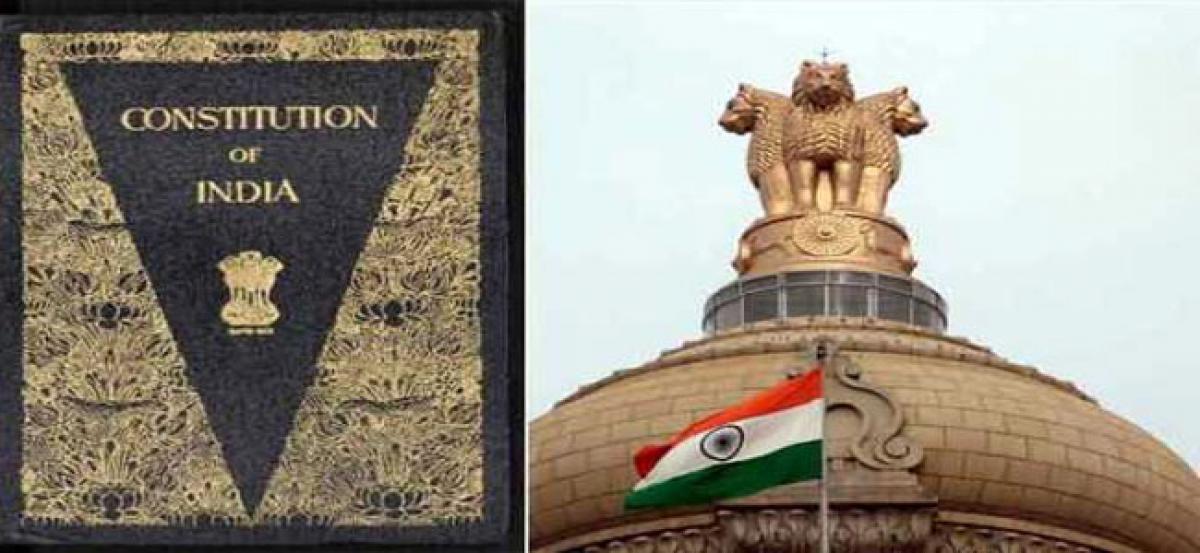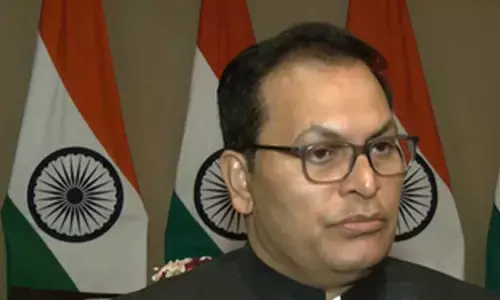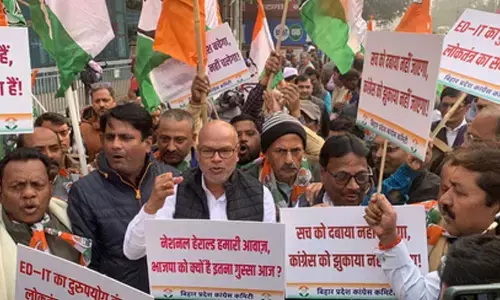Delimitation- Lifting the freeze imposed by Constitution in 2026

In a few years there is likely to be increase in number of seats in both Houses of Parliament after the lifting of the freeze imposed by the Constitution (Forty-second Amendment) Act, 1976, which is due in 2026. This will raise issues with constitutional dimensions of far-reaching importance- How these additional seats will be allocated to the States, and how to address the concerns which necessit
In a few years there is likely to be increase in number of seats in both Houses of Parliament after the lifting of the freeze imposed by the Constitution (Forty-second Amendment) Act, 1976, which is due in 2026. This will raise issues with constitutional dimensions of far-reaching importance- How these additional seats will be allocated to the States, and how to address the concerns which necessitated the freezing of the allocation of seats on the basis of the 1971 Census figures.
• Delimitation means the act or process of fixing limits or boundaries of territorial constituencies in a country or a province having a legislative body.
• The job of delimitation is assigned to a high power body. Such a body is known as Delimitation Commission or a Boundary Commission.
• This body has its origin under Article 82 of the Constitution which has provision that the Parliament by law enacts a Delimitation Act after every census.
• After coming into force commencement of the Act, the Central Government constitutes a Delimitation Commission.
Delimitation Commission
• Delimitation Commission is a statutory body and not a onstitutional body established by Central government.
• The commission’s orders have force of law and its decision cannot be challenged in any court.
• Orders are laid before Upper House and the state legislative assembly concerned, but changes/modifications are not possible by them. Basis of delimitation is Population.
• As far as possible, every state gets representation in the Lok Sabha in proportion to its population as per census figures.
• There is a gap after 1973 in setting Delimitation Commission as 42nd Constitutional Amendment Act had frozen delimitation of Lok Sabha and state legislative assembly till year 2000.
• The 84th Amendment Act of 2001 amended Article 82 and provided for fresh delimitation of constituencies on the basis of 1991 census figures.
• Commensurate to this, Delimitation Act, 2002 was enacted. Later on, 87th Amendment was made in 2003 which amended Article 82 and it provided delimitation on the basis of 2001 census figure.
Constitutional provisions
• According to Article 81 of the Constitution — as it stood before the Constitution (Forty-second Amendment) Act, 1976 — the Lok Sabha was to comprise of not more than 550 members.
• Clause (2) of Article 81 provided that for the purposes of sub-clause (a) of clause (1), there shall be allotted to each State a number of seats in the House of the People in such manner that the ratio between that number and the population of the State is, so far as practicable, the same for all States.
• Further, clause (3) defined the expression “population” for the purposes of Article 81 to mean the population as ascertained at the last preceding Census of which the relevant figures have been published.
• As result of this mandate, States which took a lead in population control faced the prospect of their number of seats getting reduced and States which had higher population figures stood to gain by increase in the number of seats in Lok Sabha.
• To allay this apprehension, Section 15 of the Constitution (Forty-second Amendment) Act, 1976 effected a freeze on the population figure with reference to the 1971 Census (which was 54.81 crore with a registered electorate of 27.4 crore) for the purposes of proviso to Article 81(3)(i) until the relevant figures for the first Census taken after the year 2000 have been published.
• Section 3 of the Constitution (Eighty-fourth Amendment), Act 2001 extended the deadline from 2000 to 2026.
The Constitution (Eighty-fourth Amendment) Act, 2001 and the Constitution (Eighty-seventh Amendment) Act, 2003 have, inter alia, amended Articles 81, 82, 170, 330 and 332 of the Constitution of India. The cumulative effect of these amendments to the Constitution is that
(i) the total number of existing seats as allocated to various states in the House of the People on the basis of 1971 census shall remain unaltered till the first census to be taken after the year 2026;
(ii) the total number of existing seats in the Legislative Assemblies of all states as fixed on the basis of 1971 census shall also remain unaltered till the first census to be taken after the year 2026;
(iii) the number of seats to be reserved for the Scheduled Castes (SCs) and Scheduled Tribes (STs) in the House of the People and State Legislative Assemblies shall be re-worked out on the basis of 2001 census;
(iv) each state shall be re-delimited into territorial parliamentary and assembly constituencies on the basis of 2001 census and the extent of such constituencies as delimited now shall remain frozen till the first census to be taken after the year 2026; and
(v)the constituencies shall be so re-delimited that population (on the basis of 2001 census) of each parliamentary and assembly constituency in a state shall, so far as practicable, be the same throughout the state.
42nd Amendment
• The Constitution (Forty Second Amendment) Act 1976 imposed a freeze on the population figure for readjustment at the 1971 census and has been extended by the Constitution (Eighty-fourth Amendment) Act 2001 till 2026.
• As a result the House of the People today represents the population figure of 1971 census whereas our population has increased manifold in the recent decades.
• This gives rise to an anomalous situation wherein today, India has over 800 million voters and 543 Lok Sabha Constituencies represent 1.28 billion people.
• To give true expression to the will of the people, it is time that we look at the legal provisions on the delimitation of the Parliamentary constituencies with a view to increase their number.
• If Great Britain can have more than 600 Parliamentary constituencies, why can’t India, with a much higher population, have more number of seats, the President asked.
Background of 42nd Amendment
• 42nd amendment was the only amendment that attempted to change the Basic structure of Constitution.
• Firstly, it amended the preamble to our constitution by adding words like “Socialist”, “Secular”, etc, which were not needed. Reason is that justice, liberty, equality and fraternity , these were already written down in constitution, which indirectly gave the socialist , secular nature to our constitution. Adding it separately made it appear like we were tending more to socialist block (other block being capitalist block), nd thus changed the nature of preamble which is basically a very concise form of constitution.
• It also changed the 7th schedule which gives three lists: Union list, State list and Concurrent list. It transferred five subjects from State list to concurrent list.
• It added fundamental duties to our constitution under article 51A. It changed the nature of constitution because if courts read Part 3 (fundamental rights to citizens) in harmony with fundamental duties of citizens and thus narrows down the concept of fundamental rights.
• Example can be like if you go to court for violation of any your fundamental right, if court may counter your logic by asking whether you fulfilled your fundamental duty regarding that fundamental right and if you are not acknowledged to this fact, your fundamental right violation might become a secondary case.
• It made President bound to the advice of cabinet, and thus curtailed the freedom of president.
• It amended Article 368, and what amendment it made was that it made constitutional amendmentsabove judicial review,i.e.,judiciary can’t check the constitutional validity of constitutional amendments.
• It amended several articles and thus brought several laws above judicial review like Article 32C, 32D,etc.
• Article 31C was added in constitution. What it added to constitution was that any law that is made to implement any directive principles of state policy will be above judicial review.
• This was exactly opposite of what was the basic soul of 1949 constitution.
• By adding 257A, it allowed Centre to deploy central forces in State to deal with grave situation of law and order. It hampered the sovereignty of state, especially in today states where the ruling government was of different party than that of centre.
• By Article 329A, it gave special discriminatory powers to speaker of Lok Sabha and Prime Minister.
• So, Several amendments like 31 – A,B,C,D and 51A increased the burden on fundamental rights.
• And thus, it’s considered as a Mini review of Constitution or Mini Constitution itself.
84 Amendment Act
• Statement of Objects and Reasons appended to the Constitution (Ninty First Amendment) Bill, 2000 which was enacted as the Constitution (Eighty Fourth Amendment) Act, 2002.
Statement of object and reasons
1 Provisos to articles 82 and 170 (3) of the Constitution provide that no fresh readjustment of constituencies can be undertaken until the figures of the first census taken after the year 2000 are published. These provisos were inserted by the Constitution (Forty-second Amendment) Act, 1976 as a measure to boost family planning norms. Since the first census to be taken after the year 2000 has already begun, the constitutional embargo on undertaking fresh delimitation will lapse as soon as the figures of this census are published.
2. There have been consistent demands, both for and against undertaking the exercise of fresh delimitation. Keeping in view the progress of family planning programmes in different parts of the country, the Government, as part of the National Population Policy strategy, recently decided to extend the current freeze on undertaking fresh delimitation up to the year 2026 as a motivational measure to enable the State Government to pursue the agenda for population stabilisation.
3. Government has also decided to undertake readjustment and rationalization of territorial constituencies in the States, without altering the number of seats allotted to each State in the House of the People and Legislative Assemblies of the States, including the Scheduled Castes and the Scheduled Tribes constituencies, on the basis of the population ascertained at the census for the year 1991, so as to remove the imbalance caused due to uneven growth of population/electorate in different constituencies.
4. It is also proposed to refix the number of seats reserved for the Scheduled Castes and the Scheduled Tribes in the House of the People and the Legislative Assemblies of the States on the basis of the population ascertained at the census for the year 1991.
84th and 87th Amendment Acts
• In order to facilitate delimitation for the reasons cited above, two Constitution Amendment Acts were made
• Constitution (Eighty-fourth Amendment) Act, 2001 and Constitution (Eighty-seventh Amendment) Act, 2003
• These two Acts have amended Articles 81, 82, 170, 330 and 332 of the Constitution of India to the following effect:
• The total number of existing seats as allocated to various States in the House of the People on the basis of 1971 census shall remain unaltered till the first census to be taken after the year 2026;
• The total number of existing seats in the Legislative Assemblies of all States as fixed on the basis of 1971 census shall also remain unaltered till the first census to be taken after the year 2026;
• The number of seats to be reserved for the Scheduled Castes (SCs) and Scheduled Tribes (STs) in the house of the People and State Legislative Assemblies shall be re-worked out ( increase/decrease) on the basis of 2001 census;
• Each State shall be redelimited into territorial parliamentary and assembly constituencies on the basis of 2001 census and the extent of such constituencies as delimited now shall remain frozen till the first census to be taken after the year 2026; and
• The constituencies shall be so re-delimited that population (on the basis of 2001 census) of each parliamentary and assembly constituency in a State shall, so far as practicable, be the same throughout the State. (‘State’ here does not include the State of Jammu and Kashmir, but includes the National Capital Territory of Delhi and Union Territory of Pondicherry)
Methodology of the Delimitation
• Delimitation needs to be undertaken in a way as to be integrated with development of the constituency Therefore, administrative, social and geographical dimensions need to be kept in mind.
• All constituencies shall, as far as practicable, be geographically compact areas, and in delimiting them regard shall be had to the physical features, existing boundaries of administrative units, facilities of communication and public convenience.
• Each constituency in a State shall be so delimited that the population of all constituencies shall, so far as practicable, be the same throughout the State.
• Constituencies shall be delimited having regard to the administrative units, i.e., district/sub divisions/ tehsils/patwar circles, panchayat samitis/panchayats. So far as practicable, all assembly constituencies in a district shall be confined within the territorial limits of that district.
• In other words, an assembly constituency shall not ordinarily extend to more than one district. The aim is to ensure that there is proper coordination of administrative, revenue and developmental work.
• In delimiting the assembly constituencies, efforts will be made to ensure that, as far as practicable, sub-divisions/tehsils are kept intact and not unnecessarily broken. While delimiting the assembly constituencies on the basis of the administrative, units as mentioned above, the contiguity of such administrative units will be the basic requirement, so that no constituency has an enclave/island within it of certain areas belonging to another constituency and having no contiguity to the other areas of that latter constituency.
• Further, apart from contiguity, geographical features, better connectivity, means of communication, public convenience will also be kept in view and areas divided by rivers or hilly ranges or forests and other such natural barriers will not be put in the same constituency.
• No assembly constituency shall extend to more than one parliamentary constituency.
• Under the Delimitation Act 2002, seats for the SC/STs are to be reserved in the constituencies in which the percentage of their population to the total population is the largest.
Commission Recommendation and Implementation
Commission submitted its report to Union Government in 2007 and President of India signed notification for implementing the recommendation of commission in 2008. It has redefined Parliamentary and Assembly Constituency.
• The Commission recommendations are not applicable to Assam, Nagaland, Arunachal Pradesh, Manipur because delimitation exercise could not undertaken in these states due to litigation over 2001 census figures.
• Apart from this, Commission’s final order was nullified for the state of Jharkhand by the GoI because delimitation exercise had resulted in reduced number of constituencies that are reserved for Scheduled Tribes i.e from 5 to 4 in case of Parliamentary constituency and 28 to 22 in case of Assembly, so election in Jharkhand will continue to be held as per 1971 census figure.
• The duty of delimitation is assigned to a high power Body called the Delimitation Commission. Its orders have the force of law and cannot be called in question before any court
• These orders come into Force on a date to be specified by the President of India in this behalf. The copies of its orders are laid before the house of the People and the State Legislative Assembly concerned, but no modifications are permissible in them.
• So far, Delimitation Commissions have been constituted 4 times - in 1952, 1963, 1973 and in 2002.
Some facts
• Delimitation in J&K is done under state Constitution.
• Under 31st Amendment Act, delimitation exercise doesn’t apply to states and Union Territories having population less than 6 million.
• Delimitation under 2002 Act, has increased Scheduled Caste (78 to 84) and Scheduled Tribe Constituencies(38 to 42)
• Karnataka became the first state to hold election to legislative assembly as per fresh delimitation exercise.
Issue
• According to the 2011 Census, the population of our country stands at 121 crore with a registered electorate of 83.41 crore.
• Basing the 1971 Census figure of 54.81 crore to represent today’s population presents a distorted version of our democratic polity and is contrary to what is mandated under Article 81 of the Constitution.
• So when the first Census figure will be available after 2026 — that is, in 2031 — a fresh delimitation will have to done which will dramatically alter the present arrangement of seat allocation to the States in Parliament.
Concerns
• The concerns expressed by the States in 1976 which necessitated the freezing of seat allocation on the basis of 1971 population figures would appear to hold good even today and have to be addressed to the satisfaction of all stakeholders.
• How the Presiding Officers of the Houses/Legislatures will deal with such a large number of members jostling with each other to capture the attention of the Speaker to raise issues in the House. Even with the current strength of 543 members, the Speaker finds it extremely difficult to conduct the proceedings of the House.
• The Speaker’s directions and rulings are not shown proper respect, and disruptions of proceedings aggravate the problem. The sudden increase in numbers will render the task of the Speaker more difficult and onerous.
• The Zero Hour, Question Hour and the raising matters of urgent public importance, which are warp and woof our democratic fabric, will be subjected to severe strain because the 60-odd minutes which are available in the morning before the normal legislative business of the House begins will require our Parliament and Legislatures to sit for a longer duration each day during the session as well as have more number of sittings in a year than at present.
Conclusion
While 2026 is still a few years away, if we do not start a debate now on how to deal with the problems that are likely to arise, we will be forced to postpone the lifting of the freeze to a future date as was done in 2001. This will only postpone the problem for which we must find a solution sooner or later.
Expected Questions
• Eighty fourth constitutional amendment Act, 2001 set the deadline for delimitation to be 2026. Lifting of the freeze on number of seats in 2026 will raise various issues. Discuss.
Syllabus
General Studies 2
• Parliament and State Legislatures ‐ structure, functioning, conduct of business, powers & privileges and issues arising out of these.
By Gudipati Rajendera Kumar















